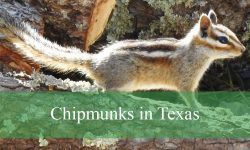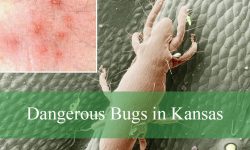Colorado hosts a wide variety of chipmunk species, ranging from the diminutive least chipmunk to the southwestern Durango and Hopi chipmunks. These small, energetic rodents are a charming part of the state’s forests, rocky slopes, and high-elevation woodlands. Their distinctive stripes and bushy tails make them easily recognizable to wildlife enthusiasts.
Chipmunks in Colorado occupy a variety of habitats. The Uinta and yellow-pine chipmunks favor coniferous and mixed forests at higher elevations, while species like the Hopi chipmunk prefer piñon-juniper woodlands and rocky terrain in southwestern regions. The Colorado chipmunk is endemic to the state, adding to its unique wildlife diversity.
Observing these chipmunks is most rewarding during dawn and late afternoon when they forage for seeds, nuts, berries, and insects. Understanding their habitats, behaviors, and seasonal patterns can help wildlife watchers and photographers spot these active little creatures safely and respectfully.
Different Types of Chipmunks Found in Colorado
Least Chipmunk (Neotamias minimus)
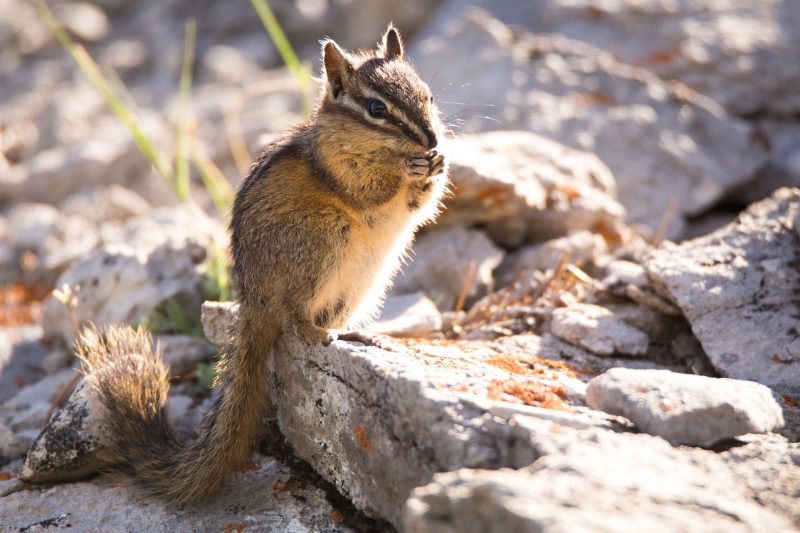
The least chipmunk is the smallest chipmunk species in Colorado, weighing only about 1–2 ounces and measuring 4–5 inches in body length, excluding the tail. Its coat is grayish-brown with five dark stripes along the back and lighter stripes on the face. The tail is bushy and moderately long, helping with balance during climbing and foraging.
These chipmunks are highly adaptable and are found in a variety of habitats, including open woodlands, shrublands, grasslands, and rocky areas. In Colorado, they are especially common in montane regions up to elevations of 10,000 feet. Their small size allows them to navigate dense ground cover and crevices where they hide from predators.
Least chipmunks are diurnal and spend much of their day foraging for seeds, nuts, berries, and insects. They are also known for their food caching behavior, storing supplies in burrows to survive the winter. Despite their small size, they are highly energetic and can be seen darting along logs, rocks, and low vegetation.
During the breeding season in spring and early summer, females give birth to litters of 3–8 young after a gestation of about 30 days. Young chipmunks remain in the burrow for a few weeks until they are independent enough to forage on their own. Adults are generally solitary outside of the mating season, defending small home ranges.
Observation of least chipmunks is best during dawn and early morning, when they are actively foraging. They are more visible in open areas with scattered rocks and shrubs. Patience and quiet movements increase the chance of spotting these tiny but energetic creatures.
Uinta Chipmunk (Neotamias umbrinus)
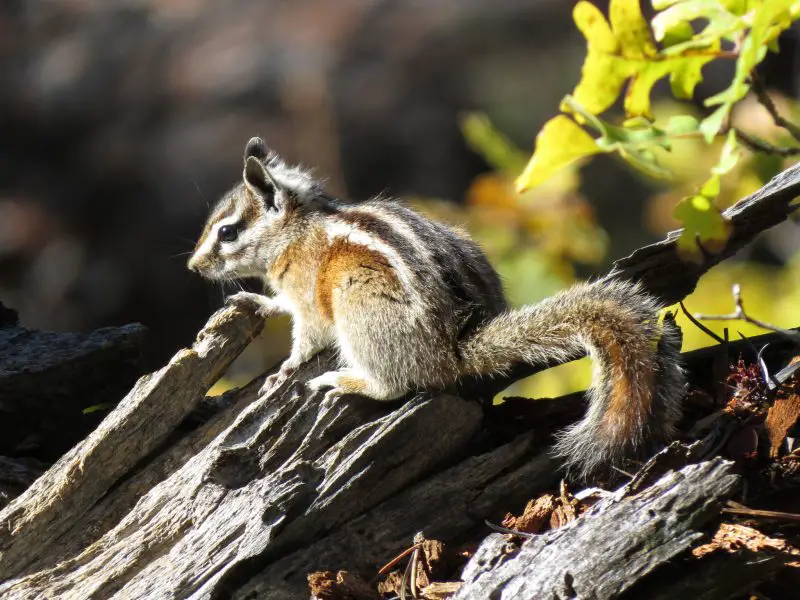
The Uinta chipmunk is a medium-sized chipmunk species, weighing 2–3 ounces with a body length of 5–6 inches. It has bold dark stripes along the back, with a reddish-brown coat on the sides and lighter underparts. Its large eyes and long whiskers aid in detecting predators in forested habitats.
Uinta chipmunks inhabit higher-elevation coniferous and mixed forests in Colorado, often between 7,000 and 11,000 feet. They prefer areas with dense tree cover and rocky outcrops, which provide both protection and nesting sites. These chipmunks are excellent climbers and can often be seen foraging in trees and shrubs.
Their diet includes seeds, nuts, berries, fruits, fungi, and insects. Uinta chipmunks are active during the day and spend much time gathering food for immediate consumption or storage in their burrows and tree cavities. They are territorial, often defending feeding areas from other chipmunks.
Breeding occurs in early spring and sometimes a second time in summer. Females produce 2–6 offspring per litter after a gestation period of about 30 days. Young are raised in burrows lined with leaves and soft plant material, learning essential survival skills from their mother.
To observe Uinta chipmunks, visit mountainous forests and rocky slopes in the morning or late afternoon. They are relatively shy, so approaching slowly and remaining quiet will increase chances of seeing them. Their reddish-brown coats make them blend with the forest floor, so careful attention is needed.
Colorado Chipmunk (Neotamias quadrivittatus)
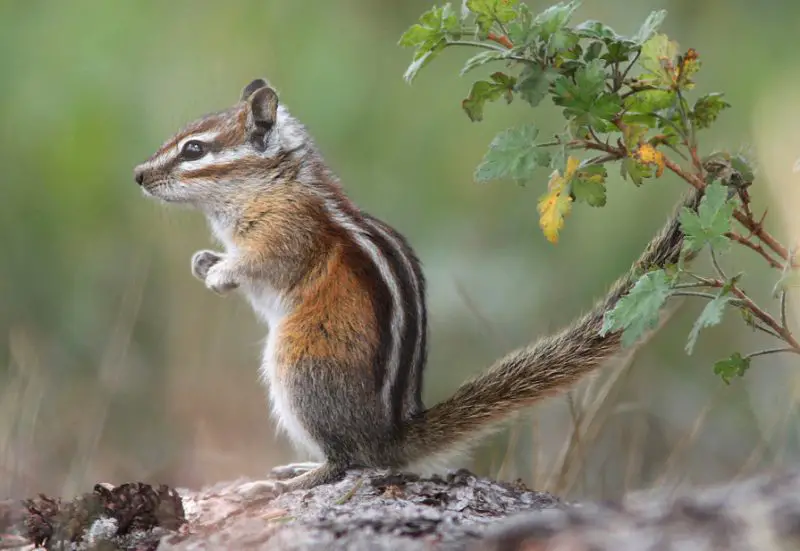
The Colorado chipmunk is a small species endemic to the state, weighing 1.5–2.5 ounces and measuring 4.5–5.5 inches in body length. It is easily identified by its distinct facial stripes and the four prominent dark stripes along its back. Its fur is reddish-brown with lighter underparts, and the tail is bushy and slightly flattened.
This chipmunk prefers montane and subalpine forests, rocky slopes, and open woodlands in Colorado. Elevations of 6,500 to 10,000 feet are common for this species, where they can find ample cover and food. They often create burrows under rocks or logs, providing shelter from predators and harsh weather.
Colorado chipmunks are omnivorous, feeding on seeds, nuts, berries, insects, and occasionally fungi. They are most active during the day, especially in the early morning and late afternoon. Their foraging habits include gathering and caching food for winter survival, often in underground burrows or hidden crevices.
Mating occurs in spring, with females producing 2–5 young per litter after about a 30-day gestation. Young remain in the burrow for several weeks before venturing out. Adults are territorial and may use vocalizations and tail movements to warn intruders away from their home range.
Observation is easiest in rocky, forested slopes and open woodland edges. Colorado chipmunks are agile and alert, so patience is necessary. Watching them forage or interact near burrow entrances provides excellent opportunities for photographers and wildlife enthusiasts.
Yellow-pine Chipmunk (Neotamias amoenus)
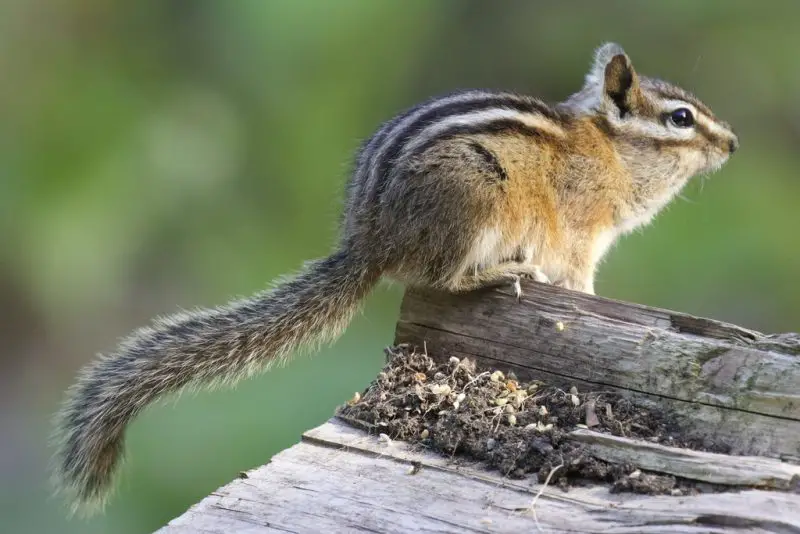
The yellow-pine chipmunk is medium-sized, weighing 2–3 ounces and measuring 5–6 inches in body length. Its coat is yellowish-brown with dark dorsal stripes and light underparts. Facial stripes and bushy tail are distinctive features, helping distinguish it from other Colorado chipmunks.
They inhabit pine and mixed conifer forests, often at elevations between 6,000 and 11,000 feet. They prefer areas with dense vegetation, fallen logs, and rocky outcrops, which provide both food sources and protection. They are excellent climbers and can forage both on the ground and in low branches.
Yellow-pine chipmunks are omnivorous, eating seeds, nuts, berries, fungi, and insects. They are highly active during daylight, often seen collecting food to store in burrows or caches. They are territorial, using vocalizations and scent marking to communicate with other chipmunks.
Breeding occurs in spring and sometimes in late summer, producing 2–6 offspring per litter after a gestation period of about 30 days. Young are raised in burrows lined with leaves and soft vegetation and become independent within a few weeks.
Observation of yellow-pine chipmunks is best during dawn or late afternoon. They are often seen along forest edges, rocky slopes, and near pine trees where they forage or gather food. Their yellowish-brown coat provides natural camouflage, so careful observation is needed to spot them.
Hopi Chipmunk (Neotamias rufus)
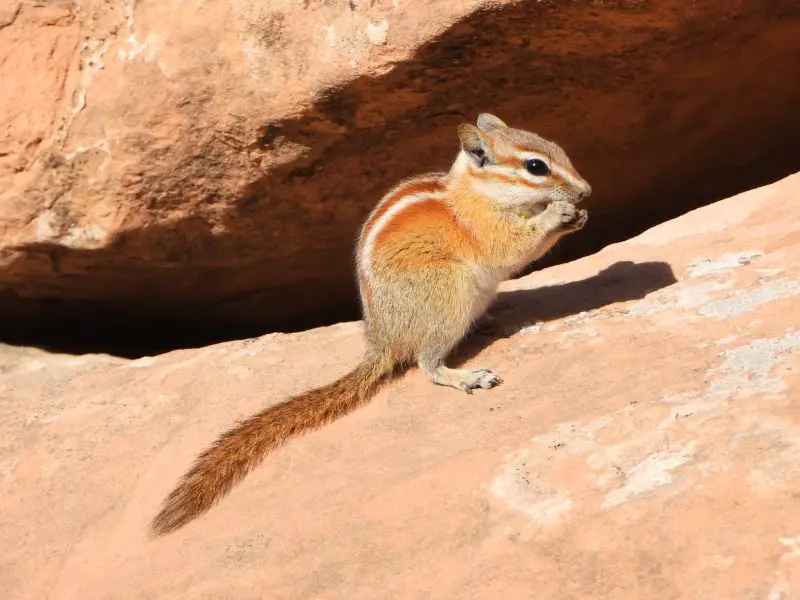
The Hopi chipmunk is a small, agile species, weighing 1.5–2.5 ounces and measuring 4.5–5.5 inches in body length. Its coat is reddish-brown with five dark stripes along the back and lighter underparts. Distinct facial stripes help differentiate it from other chipmunks in Colorado.
Hopi chipmunks are found in southwestern Colorado, particularly in piñon-juniper woodlands, rocky hillsides, and canyon slopes. They prefer habitats with abundant rocks and crevices for burrowing and hiding from predators. These chipmunks are excellent climbers, often navigating steep, rocky terrain with ease.
Their diet is omnivorous, including seeds, nuts, berries, insects, and occasional fungi. They are diurnal, actively foraging during the morning and late afternoon. Like other chipmunks, they engage in food caching, storing supplies in burrows or crevices to survive periods of scarcity.
Breeding occurs in spring, with females producing 2–5 young per litter after a gestation of about 30 days. Young remain in the burrow for several weeks, learning essential survival skills from their mother before venturing out. Adults maintain small territories and use vocalizations and tail flicking to communicate or warn intruders.
Observation of Hopi chipmunks is best in rocky slopes and piñon-juniper woodlands during early morning or late afternoon. Their reddish-brown coat blends with the environment, so careful, patient observation is needed. They are active and curious, making them fun subjects for wildlife enthusiasts and photographers.
Durango Chipmunk (Neotamias durangae)
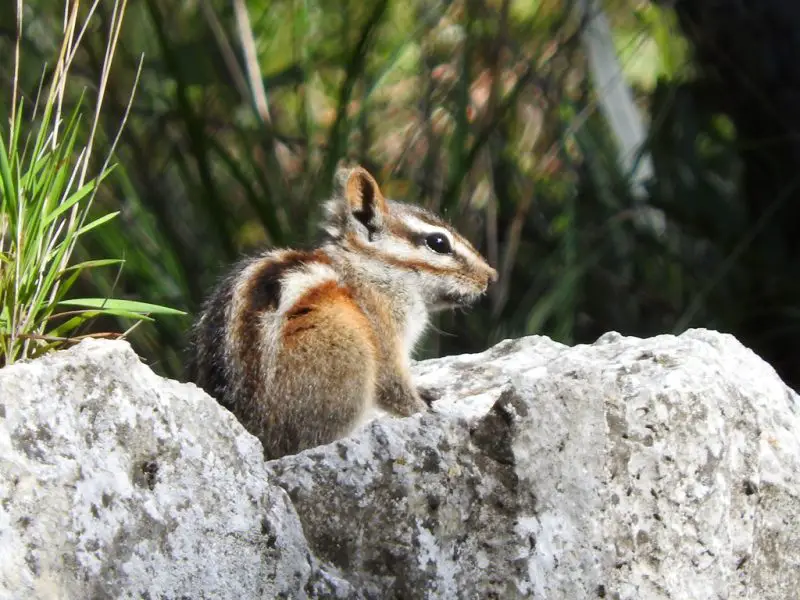
The Durango chipmunk is a medium-sized species, weighing 2–3 ounces with a body length of 5–6 inches. Its fur is reddish-brown with five bold dark stripes along the back and lighter underparts. Facial markings and a bushy tail make it distinct among southwestern Colorado chipmunks.
Durango chipmunks inhabit high-elevation forests and rugged terrain in southwestern Colorado, often between 7,000 and 11,000 feet. They prefer mixed conifer and pine forests, especially areas with abundant rocks, fallen logs, and dense vegetation for shelter.
These chipmunks are omnivorous, feeding on seeds, nuts, berries, insects, and fungi. They are diurnal and spend much of their time foraging or gathering food for storage in burrows and natural crevices. Their agility allows them to climb trees and navigate rocky terrain efficiently.
Breeding occurs in spring, with females producing 2–5 young per litter after a gestation period of roughly 30 days. Young are raised in burrows lined with soft vegetation and leave after several weeks to establish their own home ranges. Adults are territorial and often use vocalizations and scent marking to defend feeding areas.
Observation of Durango chipmunks is best in high-elevation forested slopes and rocky areas during early morning or late afternoon. They are shy and fast-moving, so patience and quiet movements are essential to spot them. Their striking reddish-brown coat makes them more visible against rocks and logs.
Eastern Chipmunk (Tamias striatus)
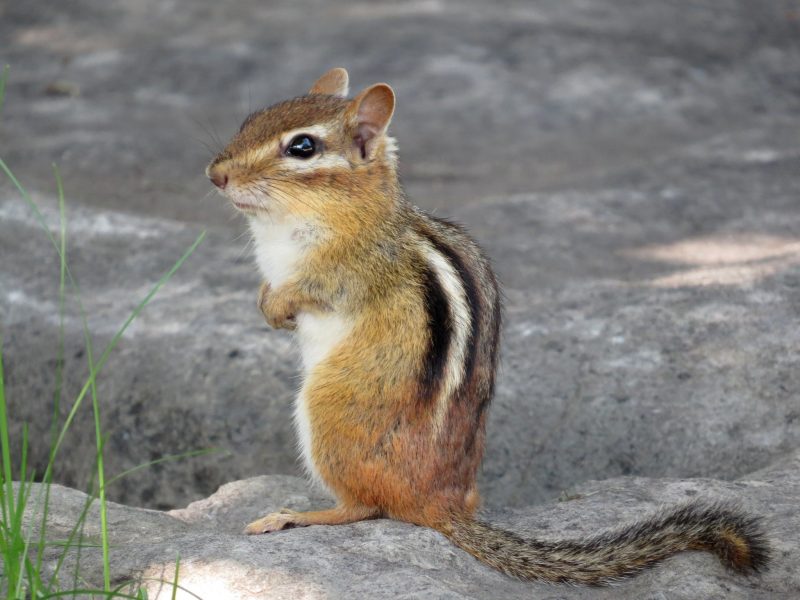
The Eastern chipmunk is a well-known species but rare in Colorado. Adults weigh 2–3 ounces and measure 5–6 inches in body length. They have reddish-brown fur with five dark stripes on their back and a bushy tail. Facial stripes and bright eyes make them easily recognizable.
In Colorado, Eastern chipmunks are mostly restricted to riparian areas, deciduous forests, and some introduced populations in the eastern part of the state. They prefer habitats with dense undergrowth, fallen logs, and abundant ground cover, which provide shelter from predators.
Their diet is primarily herbivorous, including seeds, nuts, fruits, berries, and occasionally insects. Eastern chipmunks are diurnal and spend most of the day foraging and storing food in burrows for winter survival. They are active and curious but cautious, often retreating quickly if disturbed.
Breeding occurs in early spring, with a possible second litter in summer. Females produce 2–5 young per litter after a gestation period of about 30 days. Young are raised in burrows lined with leaves and soft plant material, remaining hidden for several weeks before becoming independent.
Observation of Eastern chipmunks in Colorado is rare and usually requires visits to eastern riparian forests or private wooded properties. They are most active at dawn and early morning, where their foraging and caching behavior can be observed. Patience and quiet observation are key to spotting this uncommon species.
Best Times and Places to Observe Chipmunks in Colorado
Observing chipmunks in Colorado is most rewarding during the early morning hours around dawn and the late afternoon toward dusk, when they are actively foraging for food. Chipmunks are diurnal and spend much of their day collecting seeds, nuts, berries, and insects, making these times ideal for wildlife enthusiasts.
Least Chipmunk
Least chipmunks are common across montane regions and open woodlands, including grassy slopes, shrublands, and rocky areas. Observers are most likely to spot them darting among rocks or logs in open areas where they forage for seeds and insects.
Uinta Chipmunk
Uinta chipmunks prefer higher-elevation coniferous and mixed forests, often between 7,000–11,000 feet. Look for them near dense tree cover, rocky outcrops, or along forest trails during early morning or late afternoon for the best chance of sightings.
Colorado Chipmunk
Colorado chipmunks inhabit montane and subalpine forests, rocky slopes, and open woodlands at elevations of 6,500–10,000 feet. Observers can find them near burrows under rocks or logs, actively gathering and caching food.
Yellow-pine Chipmunk
Yellow-pine chipmunks are found in pine and mixed conifer forests, particularly areas with fallen logs and rocks. Dawn or late afternoon visits are ideal for spotting them climbing low branches or foraging on the forest floor.
Hopi and Durango Chipmunks
Both species are located in southwestern Colorado, with Hopi chipmunks in piñon-juniper woodlands and Durango chipmunks in high-elevation mixed conifer forests. Patience and quiet movements are essential, as they are wary and quick-moving.
Eastern Chipmunk
Eastern chipmunks are rare in Colorado and are mostly found in riparian forests or eastern wooded areas. Observations are best in the morning when they forage for seeds and nuts, often near fallen logs or dense underbrush.
FAQs About Chipmunks in Colorado
How many chipmunk species are found in Colorado?
There are seven recognized species in Colorado, including the least chipmunk, Uinta chipmunk, Colorado chipmunk, yellow-pine chipmunk, Hopi chipmunk, Durango chipmunk, and the rare Eastern chipmunk.
When is the best time to observe chipmunks?
Chipmunks are most active at dawn and late afternoon, which are the ideal times to watch their foraging, climbing, and food-caching behaviors.
Where are chipmunks most commonly found?
Most chipmunks inhabit forests, rocky slopes, and open woodlands, while some species like Hopi and Durango chipmunks prefer high-elevation forests and piñon-juniper habitats in southwestern Colorado.
Are chipmunks dangerous to humans?
Chipmunks are not dangerous and are generally shy. They may bite if handled, but it is best to observe them from a distance and avoid disturbing their natural behavior.
Do chipmunks hibernate in Colorado?
Most chipmunks do not fully hibernate but enter a state of torpor during winter, waking periodically to eat stored food from their burrows.

